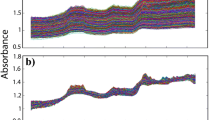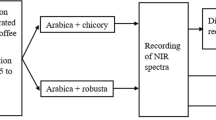Abstract
This paper proposes a novel screening method for the simultaneous detection of four adulterants (spent coffee grounds, roasted coffee husks, roasted corn, and roasted barley) in ground roasted coffee using partial least squares discriminant analysis (PLS-DA) with mid-infrared spectroscopy. Two different acquisition modes (attenuated total reflectance, ATR, and diffuse reflectance, DR) are compared. Two recent chemometric approaches, hierarchical models (HM) and data fusion (DF), were employed in order to improve model performance. First level models provided discrimination between unadulterated and adulterated coffee samples, whereas second level models were able to identify the presence of each specific adulterant. The use of DF decreased the percentage of misclassified samples for the first level models from 19.6/14.7% (DR) and 7.5/14.5% (ATR) down to 2.5/4.5% considering the training/test sets. The percentage of misclassified samples in the second level models went as low as 0% (DF—spent coffee, training set). The proposed method is simple, fast, reliable for detecting adulteration in coffee samples, and capable of identifying these adulterants, even when in complex mixtures containing other adulterants.



Similar content being viewed by others
References
Aquino FJT, Augusti R, Alves JDO, Diniz MER, Morais SAL, Alves BHP, Nascimento EA, Sabino AA (2014) Direct infusion electrospray ionization mass spectrometry applied to the detection of forgeries: roasted coffees adulterated with their husks. Microchem J 117:127–132
Barbin DF, Felicio ALDSM, Sun DW, Nixdorf SL, Hirooka EY (2014) Application of infrared spectral techniques on quality and compositional attributes of coffee: an overview. Food Res Int 61:23–32
Borràs E, Ferré J, Boqué R, Mestres M, Aceña L, Busto O (2015) Data fusion methodologies for food and beverage authentication and quality assessment—a review. Anal Chim Acta 891:1–14
Bruwer MJ, Macgregor JF, Bourg WM (2007) Fusion of sensory and mechanical testing data to define measures of snack food texture. Food Qual Prefer 18:890–900
Cai T, Ting H, Jin-Lan Z (2016) Novel identification strategy for ground coffee adulteration based on UPLC–HRMS oligosaccharide profiling. Food Chem 190:1046–1049
Craig AP, Franca AS, Oliveira LS (2011) Discrimination between immature and mature green coffees by attenuated total reflectance and diffuse reflectance Fourier transform infrared spectroscopy. J Food Sci 76:C1162–C1168
Craig AP, Franca AS, Oliveira LS (2012) Evaluation of the potential of FTIR and chemometrics for separation between defective and non-defective coffees. Food Chem 132:1368–1374
Domingues DS, Pauli ED, De Abreu JEM, Massura FW, Cristiano V, Santos MJ, Nixdorf SL (2014) Detection of roasted and ground coffee adulteration by HPLC by amperometric and by post-column derivatization UV-Vis detection. Food Chem 146:353–362
Drivelos SA, Higgins K, Kalivas JH, Haroutounian SA, Georgiou CA (2014) Data fusion for food authentication. Combining rare earth elements and trace metals to discriminate “fava Santorinis” from other yellow split peas using chemometric tools. Food Chem 165:316–322
Esslinger S, Riedl J (2014) Potential and limitations of non-targeted fingerprinting for authentication of food in official control. Food Res Int 60:189–204
Garcia LMZ, Pauli ED, Valderi C, Camara CAP, Scarminio IS, Nixdorf SL (2009) Chemometric evaluation of adulteration profile in coffee due to corn and husk by determining carbohydrates using HPAEC-PAD. J Chromatogr Sci 47:825–832
Hong X, Wang J, Qiu S (2014) Authenticating cherry tomato juices—discussion of different data standardization and fusion approaches based on electronic nose and tongue. Food Res Int 60:173–179
Kizil R, Irudayaraj J, Seetharaman K (2002) Characterization of irradiated starches by using FT-Raman and FTIR spectroscopy. J Agric Food Chem 50:3912–3918
Li H, Chen Q, Zhao J, Wu M (2015) Nondestructive detection of total volatile basic nitrogen (TVB-N) content in pork meat by integrating hyperspectral imaging and colorimetric sensor combined with a nonlinear data fusion. LWT - Food Sci Technol 63:268–274
Oliveira RCS, Oliveira LS, Franca AS, Augusti R (2009) Evaluation of the potential of SPME-GC-MS and chemometrics to detect adulteration of ground roasted coffee with roasted barley. J Food Compos Anal 22:257–261
Olivieri AC (2014) Analytical figures of merit: from univariate to multiway calibration. Chem Rev 114:5358–5378
Reis N, Franca AS, Oliveira LS (2013a) Performance of diffuse reflectance infrared Fourier transform spectroscopy and chemometrics for detection of multiple adulterants in roasted and ground coffee. LWT - Food Sci Technol 53:395–401
Reis N, Franca AS, Oliveira LS (2013b) Quantitative evaluation of multiple adulterants in roasted coffee by diffuse reflectance infrared Fourier transform spectroscopy (DRIFTS) and chemometrics. Talanta 115:563–568
Reis N, Franca AS, Oliveira LS (2013c) Discrimination between roasted coffee, roasted corn and coffee husks by diffuse reflectance infrared Fourier transform spectroscopy. LWT Food Sci Technol 50:715–722
Ribeiro JS, Salva TJ, Ferreira MMC (2010) Chemometric studies for quality control of processed brazilian coffees using DRIFTS. J Food Qual 33:212–227
Sano EE, Assad ED, Cunha SAR, Correa TBS, Rodrigues HR (2003) Quantifying adulteration in roast coffee powders by digital image processing. J Food Qual 26:123–134
Silvestri M, Elia A, Bertelli D, Salvatore E, Durante C, Li Vigni M, Marchetti A, Cocchi M (2014) A mid level data fusion strategy for the varietal classification of Lambrusco PDO wines. Chemom Intell Lab Syst 137:181–189
Smolinska A, Posma JM, Blanchet L, Ampt KA, Attali A, Tuinstra T, Luider T, Doskocz M, Michiels PJ, Girard FC, Buydens LM, Wijmenga SS (2012) Simultaneous analysis of plasma and CSF by NMR and hierarchical models fusion. Anal Bioanal Chem 403:947–959
Souto UTCP, Barbosa MF, Dantas HV, Pontes AS, Lyra WS, Diniz PHGD, Araújo MCU, Silva EC (2015a) Identification of adulteration in ground roasted coffees using UV–Vis spectroscopy and SPA-LDA. LWT - Food Sci Technol 63:1037–1041
Souto UTCP, Barbosa MF, Dantas HV, Pontes AS, Lyra WS, Diniz PHGD, Araújo MCU, Silva EC (2015b) Screening for coffee adulteration using digital images and SPA-LDA. Food Anal Methods 8:1515–1521
Szymańska E, Saccenti E, Smilde AK, Westerhuis JA (2012) Double-check: validation of diagnostic statistics for PLS-DA models in metabolomics studies. Metabolomics 8:3–16
Tan J, Li R, Jiang ZT (2015) Chemometric classification of Chinese lager beers according to manufacturer based on data fusion of fluorescence. UV and visible spectroscopies Food Chem 184:30–36
Acknowledgements
The authors acknowledge financial support from the following Brazilian Government Agencies: CAPES, CNPq, and FAPEMIG.
Author information
Authors and Affiliations
Corresponding author
Ethics declarations
Conflict of Interest
Nadia Reis declares that she has no conflict of interest. Bruno Botelho declares that he has no conflict of interest. Adriana S. Franca declares that she has no conflict of interest. Leandro S. Oliveira declares that he has no conflict of interest.
Ethical Approval
This article does not contain any studies with human participants or animals performed by any of the authors.
Informed Consent
Not applicable.
Rights and permissions
About this article
Cite this article
Reis, N., Botelho, B.G., Franca, A.S. et al. Simultaneous Detection of Multiple Adulterants in Ground Roasted Coffee by ATR-FTIR Spectroscopy and Data Fusion. Food Anal. Methods 10, 2700–2709 (2017). https://doi.org/10.1007/s12161-017-0832-3
Received:
Accepted:
Published:
Issue Date:
DOI: https://doi.org/10.1007/s12161-017-0832-3




